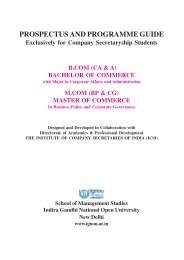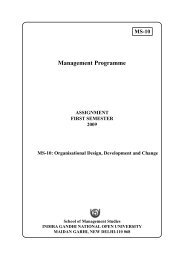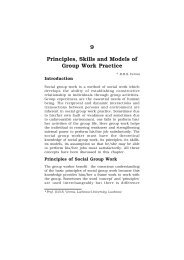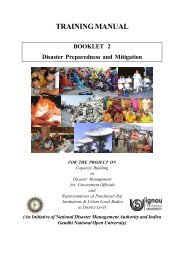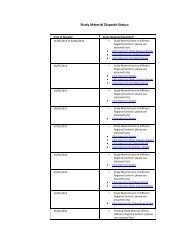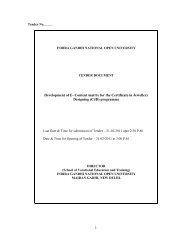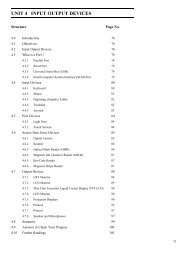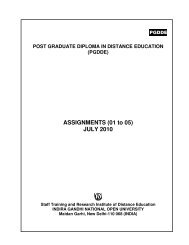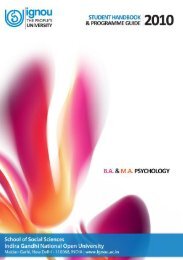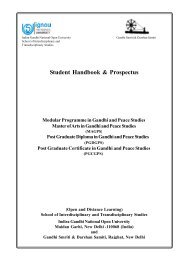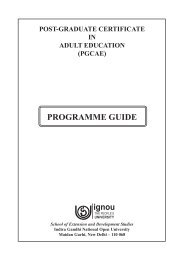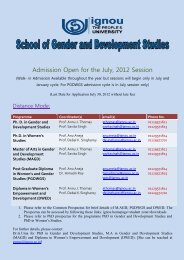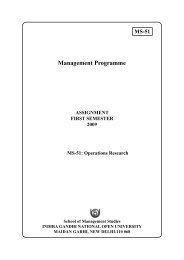Disaster Recovery and the Road Ahead - IGNOU
Disaster Recovery and the Road Ahead - IGNOU
Disaster Recovery and the Road Ahead - IGNOU
You also want an ePaper? Increase the reach of your titles
YUMPU automatically turns print PDFs into web optimized ePapers that Google loves.
ANNEXURE 2<br />
CASE STUDIES<br />
COORDINATION<br />
The aftermath of Gujarat Earthquake 2001 saw a pouring of many national <strong>and</strong> international agencies<br />
such as Self-Employed Women’s Association (SEWA), Australian Red Cross, United Nations Children<br />
Emergency Fund (UNICEF), Oxfam etc. These Agencies have done substantial work in rescuing<br />
survivors from debris; providing food, shelter, water <strong>and</strong> basic sanitation; arranging for medical<br />
supplies <strong>and</strong> so on. The coordination <strong>and</strong> cooperation between <strong>the</strong>se Agencies has made <strong>the</strong> task<br />
of rebuilding <strong>and</strong> rehabilitation in Gujarat a reality today.<br />
INSURANCE<br />
In 2002, a majority of <strong>the</strong> 2001 Gujarat Earthquake relief beneficiaries were still exposed to<br />
disaster-induced financial losses. Various studies-including <strong>the</strong> Gujarat Community Survey of 2002<br />
by <strong>the</strong> Gujarat-based All India <strong>Disaster</strong> Mitigation Institute (AIDMI) <strong>and</strong> ProVention Consortium -<br />
revealed that access to risk transfer was correlated with sustainable economic recovery among<br />
victims, yet only 2 per cent of those surveyed had insurance. A micro-insurance scheme was<br />
designed to augment AIDMI’s ongoing Livelihood Relief Fund activities. The resultant scheme,<br />
called “Afat Vimo” was <strong>the</strong> result of extensive discussions <strong>and</strong> negotiations with insurance providers<br />
who could be interested in supplying low-premium insurance policies to poor clients. Afat Vimo<br />
policyholders are covered for damage or loss up to <strong>the</strong> value of 1,744 US dollars for non-life assets<br />
<strong>and</strong> 465 US dollars for loss of life, which gives a total damage <strong>and</strong> loss coverage of 2,209 US<br />
dollars. Current Afat Vimo clients include 5,054 individuals from low income households with an<br />
annual income of 280 US dollars.<br />
The scheme covers 19 disasters including fires, explosions, riots, malicious damage, aircraft damage,<br />
cyclones, tempests, floods, inundation, earthquakes, lightening, implosions, strikes, impact damage,<br />
storms, typhoons, hurricanes, tornados <strong>and</strong> l<strong>and</strong>slides. Afat Vimo policy holders are also supported<br />
with micro-mitigation measures such as fire-safety training, seismic-safe construction practices <strong>and</strong><br />
business development services. The Afat Vimo scheme is part of <strong>the</strong> Regional Risk Transfer Initiative<br />
(RRTI), an Action Learning Project (ALP) of <strong>the</strong> Gujarat based AIDMI. The RRTI teaches insurance<br />
companies, authorities, donor communities <strong>and</strong> NGOs how to facilitate a convergence between<br />
micro-finance tools <strong>and</strong> disaster risk reduction strategies. The scheme represents an innovative<br />
approach to risk identification, pooling <strong>and</strong> transfer, which recognizes <strong>the</strong> fact that <strong>the</strong> majority of<br />
poor disaster victims have little or no access to risk transfer schemes.<br />
COMMUNITY PARTICIPATION<br />
The Maharashtra Emergency Earthquake Rehabilitation Programme (MEERP) is a classic model for<br />
resettlement <strong>and</strong> rehabilitation of large groups of communities with provision of housing, infrastructural<br />
<strong>and</strong> o<strong>the</strong>r socio-economic facilities, in a sustainable manner. Active participation of <strong>the</strong> affected<br />
people for both pre-construction <strong>and</strong> post-construction activities has facilitated <strong>the</strong> implementation<br />
of both <strong>the</strong> rehabilitation policy <strong>and</strong> <strong>the</strong> programme successfully. The objective has been to extend<br />
community participation beyond <strong>the</strong> consent of <strong>the</strong> Sarpanches (village leaders) <strong>and</strong> ensure that <strong>the</strong><br />
views of all sections of <strong>the</strong> community are sought <strong>and</strong> understood. The involvement of <strong>the</strong> communities<br />
79



